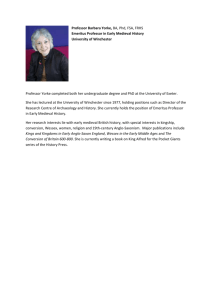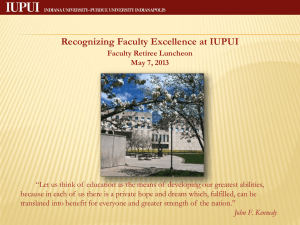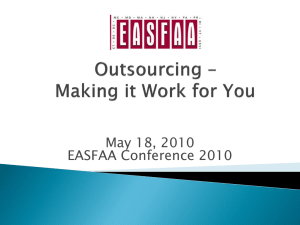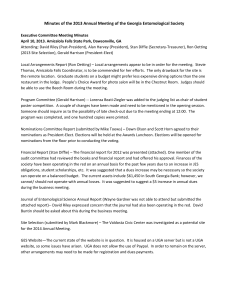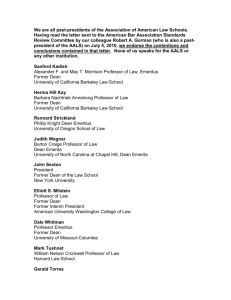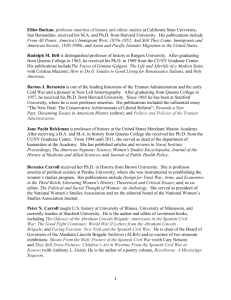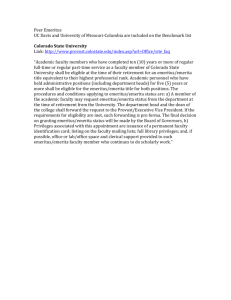Emeritus College Planning Group meeting report for 1-28
advertisement
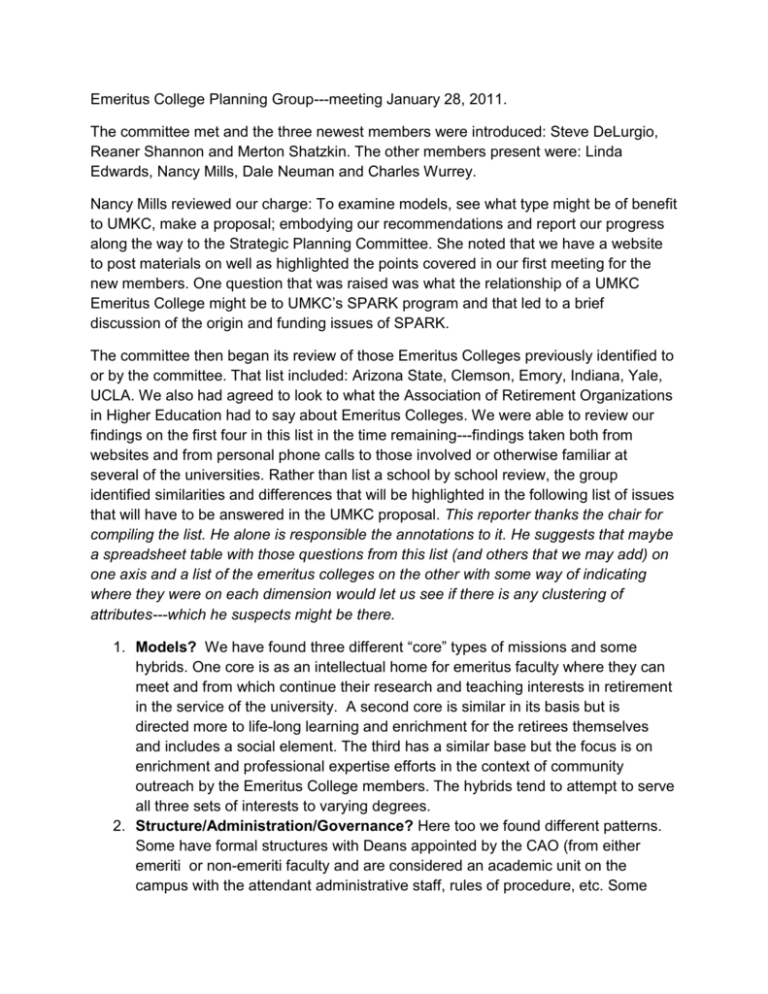
Emeritus College Planning Group---meeting January 28, 2011. The committee met and the three newest members were introduced: Steve DeLurgio, Reaner Shannon and Merton Shatzkin. The other members present were: Linda Edwards, Nancy Mills, Dale Neuman and Charles Wurrey. Nancy Mills reviewed our charge: To examine models, see what type might be of benefit to UMKC, make a proposal; embodying our recommendations and report our progress along the way to the Strategic Planning Committee. She noted that we have a website to post materials on well as highlighted the points covered in our first meeting for the new members. One question that was raised was what the relationship of a UMKC Emeritus College might be to UMKC’s SPARK program and that led to a brief discussion of the origin and funding issues of SPARK. The committee then began its review of those Emeritus Colleges previously identified to or by the committee. That list included: Arizona State, Clemson, Emory, Indiana, Yale, UCLA. We also had agreed to look to what the Association of Retirement Organizations in Higher Education had to say about Emeritus Colleges. We were able to review our findings on the first four in this list in the time remaining---findings taken both from websites and from personal phone calls to those involved or otherwise familiar at several of the universities. Rather than list a school by school review, the group identified similarities and differences that will be highlighted in the following list of issues that will have to be answered in the UMKC proposal. This reporter thanks the chair for compiling the list. He alone is responsible the annotations to it. He suggests that maybe a spreadsheet table with those questions from this list (and others that we may add) on one axis and a list of the emeritus colleges on the other with some way of indicating where they were on each dimension would let us see if there is any clustering of attributes---which he suspects might be there. 1. Models? We have found three different “core” types of missions and some hybrids. One core is as an intellectual home for emeritus faculty where they can meet and from which continue their research and teaching interests in retirement in the service of the university. A second core is similar in its basis but is directed more to life-long learning and enrichment for the retirees themselves and includes a social element. The third has a similar base but the focus is on enrichment and professional expertise efforts in the context of community outreach by the Emeritus College members. The hybrids tend to attempt to serve all three sets of interests to varying degrees. 2. Structure/Administration/Governance? Here too we found different patterns. Some have formal structures with Deans appointed by the CAO (from either emeriti or non-emeriti faculty and are considered an academic unit on the campus with the attendant administrative staff, rules of procedure, etc. Some 3. 4. 5. 6. Deans are rotating positions reviewed by an advisory committee while others serve at the pleasure of the appointing officer---usually the Provost. Others with more structure (but that are not part of the campus academic organization) still operate with by-laws for self-governance, an advisory committee to the director and an operational committee structure related to functions/activities, an official membership, dues, hours of operation, rules for use of space, etc. Others are less structured but may have a director and/or staff (full-time or part-time) that handle the scheduling of activities, processing inquiries, doing the general administrative tasks for the Emeritus College. Some use newsletters and/or have their own websites as part of the institution’s web presence. Space? There is variety here as well, as some have a house that is the hub of all (mostly social or enrichment) activities while others have a house or building or other space that serves as the administrative home. Some provide office spaces assigned for fixed but renewable terms, conference rooms, computer and other support for emeritus college faculty members to accomplish the Emeritus College mission. Budget/Funding Sources? Where the Emeritus College is an academic unit, its founding comes through the institution plus any endowment to the Emeritus College. Where it is not so linked, its funding appears to be more limited and less certain except in the case where a founding endowment may be in place that covers space and support, etc. Several have membership dues as well as opportunities to donate to the support of the Emeritus College. Some provide modest travel or research or lectureship honoraria support that in most cases is created by named endowments for the specific purpose by emeritus faculty or their families as memorials. Membership? There is a range of definitions here as well. Some are only open to current emeritus faculty while others include those planning to retire as well. Another is open to emeriti faculty and librarians, their spouses, surviving spouses, and partners. Some are open to emeriti from other four-year institutions as well as campus faculty who are not emeritus under different membership categories. Some are open to “others” who support the mission of the Emeritus College. In most cases it seems that emeritus status confers regular membership but that persons other than emeriti must be invited or approved before they can join and then as a special category. Even where qualifying for membership may be automatic (by definition), there may be application and/or other forms to elicit information on expertise and interests as well as to pay dues or make donations. Not all require dues and those that do seem to have started at modest levels while one had a proposal pending to raise theirs to $75. Impact on other campus groups? A question in our minds was to look for information for several reasons related to UMKC’s current organization. With SPARK already serving as one vehicle for life-long learning on campus and with pending developments/ elaborations of the Honors College, Student Success Center, University College, etc., some of the functions associated with other examples of Emeritus Colleges were seen as possibly duplicative of existing or planned efforts at UMKC( e.g. mentoring, special lectures for special audiences). And what we found was that there is a range here, as some have their calendars of activities as part of the campus calendar; the advisory committees for some include non-retired faculty; some specifically engage the emeriti college faculty with students as mentors, as the course instructor or as guest lecturer; one has its members creating an oral history of the institution. One sees emeritus college faculty as mentors for new and younger faculty. One has a committee to advise its university on emeritus policy while another specifically stipulates that its emeritus college members will have no role related to policies related to governing the awarding of emeritus status. Some have representation on the campus faculty governance body (e.g. a Senate). Some use emeritus college faculty to travel and meet with alumni. So “impact” seems to depend on campusspecific issues of the past and the particular needs of its current organization. 7. Links to the Community? The information here suggests that the mission statement may set limits or open opportunities that are then incorporated in some way in the structure of the Emeritus College. Membership application forms may ask for information on expertise for the purpose of setting up lectures for the broader community. Some advisory committees to the Dean or Director of the Emeritus College may include community members or campus officials associated with continuing learning precisely to facilitate outreach. Some have specific endowments to cover costs of taking a speaker into the community. 8. Links to other Retiree Groups? In terms of membership, this seems governed by the specific limits set in the organization’s by-laws. Some permit “others” committed to the purpose/mission of the Emeritus College to join. Out-reach and some on-campus programs of most Emeritus Colleges reviewed could clearly serve the intellectual interests of other retirees. I did not note any specific references to link with other campus retiree organizations, per se, and that will be an issue to be addressed at UMKC. 9. Relation to UMKC/UM policy on emeritus status and with the UMKC Senate? See commentary on items 2 and 6 above. 10. Constituent Groups with which to Meet? See commentary on items 2,5,6 & 7. 11. Plan for Writing the UMKC Proposal? To be determined.

